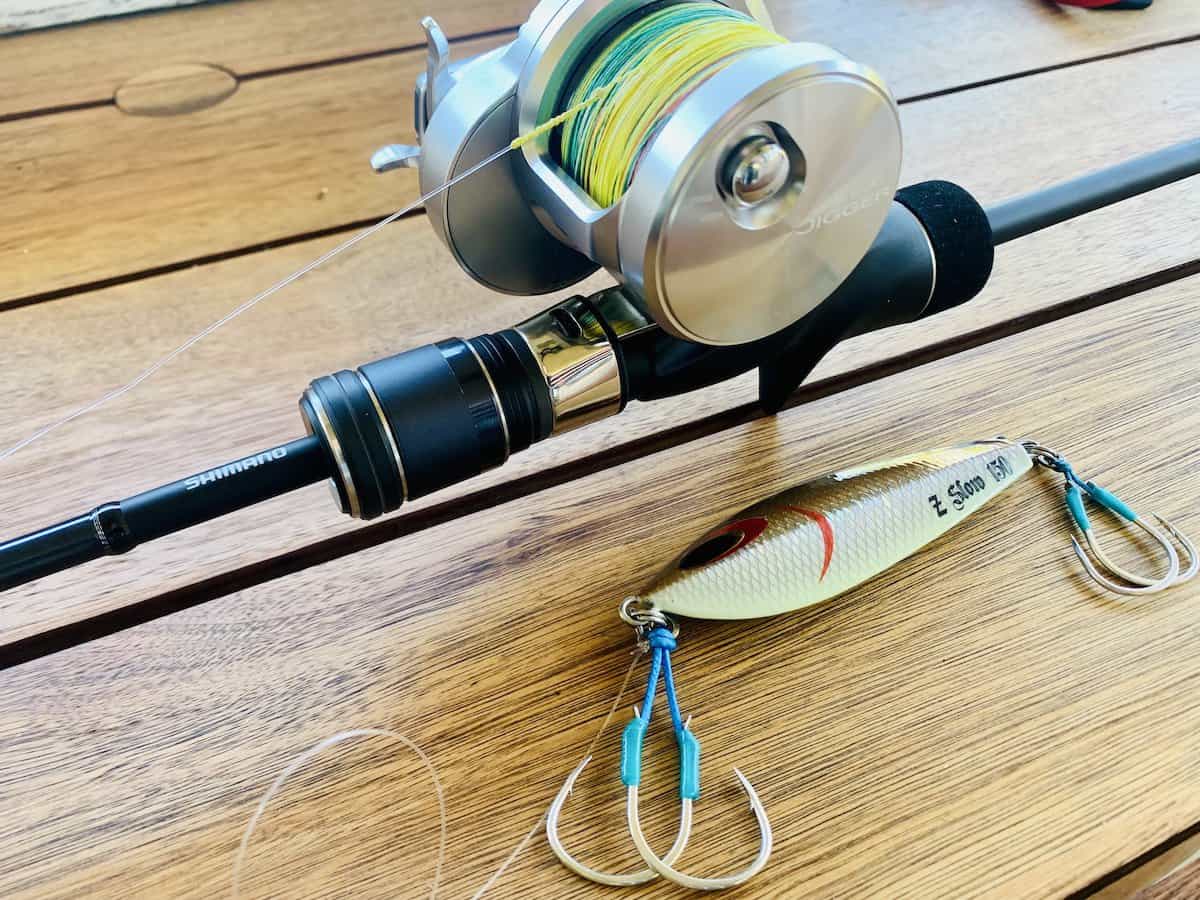How to Do The Slow Pitch Technique
Slow pitch jigging is a unique fishing method in which the jig imitates a dead baitfish and the jig is normally struck during the fall. It’s a technique that is gaining in popularity in the United States. The method requires highly specialized tackle, which tends to drive up the cost of the equipment.
In slow pitch jigging, a heavy jig is tied to the line, with anywhere between 1 and 4 hooks, and dropped to the ocean floor in a controlled freespool. As the jig falls, it turns horizontally and wobbles on the way down. Once the jig reaches the bottom, the angler slowly pulls the rod tip up, while keeping the butt end of the rod under his or her armpit. Then the angler points the rod tip down at a speed faster than the lure, so that there is slack in the line. Most other fishing methods avoid slack in the line, however slack is necessary for proper jig action when slow pitch jigging.
The angler can retrieve the line during the jig up or during the freefall down, whichever the angler prefers. The main point is to maintain slack in the line as the jig falls. Some anglers find it easier to keep slack in the line if they reel in on the jig up. As you might imagine, it can be challenging to hook a fish on a slack line. This is where the hooks become important.
A light wire hook has such a small and sharp point that it can penetrate a fish even when there isn’t slack in the line. However, there is risk that a light wire hook can bend once a fish is hooked. The light wire hooks on slow pitch jigs often come in a pair to increase the likelihood of a mouth hook and another hook somewhere else on the fish. Two light wire hooks penetrating the fish can prevent a fish bending a hook and getting away. Twin light wire hooks are most often used on smaller jigs.
Heavy wire hooks are also used, and you’ll often see these ones sold as a single hook with a heavy cord. This is because the heavy wire hook with a sharp point can penetrate a fish’s mouth and keep the fish hooked without fear of the hook bending. Heavy wire hooks are most often used on larger jigs because they are more resilient to a big hook falling impacting it’s action.
Once a fish is hooked, the angler retrieves the line in the reel to land the fish. Some anglers are fearful during this part of the process because the noodle-y rods will bend a lot. The rods have a slow, parabolic action to help work the jig in a slow and rhythmic fashion. This is where the retrieve rate of the reel and the powerful reel handle becomes an advantage.
Anglers will hold the rod mostly horizontal, keeping the butt end of the rod under his or her armpit, and crank the handle of the reel to land to fish. Like most light tackle fishing methods, this technique is exciting for fishermen of all experience levels.
Target Bottom Dwellers with Slow Pitch Jigging
Most often, bottom-dwelling species are targeted with a slow pitch jigging technique. These species include grouper, snapper, and flounder.
These species are most active at different times of year. October through April is best for targeting grouper. May through September is best for targeting snapper. March through June and September through November is best for targeting flounder. During these specific months, these species are more active.
Many bottom species hang out around heavy structure such as reefs and wrecks. These areas give plenty of hiding spaces for the fish and also for the baitfish they feed on. To successfully catch one of these fish, you’ll need to present your slow jig properly right near the bottom of the ocean, over and over again.
Other bottom species such as flounder and tilefish are found in sandy and muddy bottom. This tends to make them harder to locate, but they can still be targeted with slow pitch jigs presented at the bottom of the water column.
Although bottom species are the most common species to target with this technique, pelagics such as tuna can be targeted as well. Pelagics are known for hanging around the middle of the water column, so instead of dropping your jig all the way to the ocean floor, you can drop it to a specific depth and work it there.
A fishfinder can help you locate the depth of tuna, and multi-colored braided line, like PowerPro Depth Hunter, can help you know when your jig has dropped to the right depth.
Slow Pitch Rods Have Slow Action
The rod is one of the most critical parts of slow pitch jigging. It must be able to create a rhythmic up and down motion of the jig. It also must be extremely lightweight because anglers will often do this technique for extended period of time.
A slow action creates a long parabolic bend in the rod. This allows the jig to be pulled up and slowly change to a freefall on slack line. A fast action rod would simply create a far too jerky motion for the jig to be presented properly. The bend in the rod must also reach all the way to the butt section of the rod. For this to happen, a split grip on the butt end of the rod is a must.
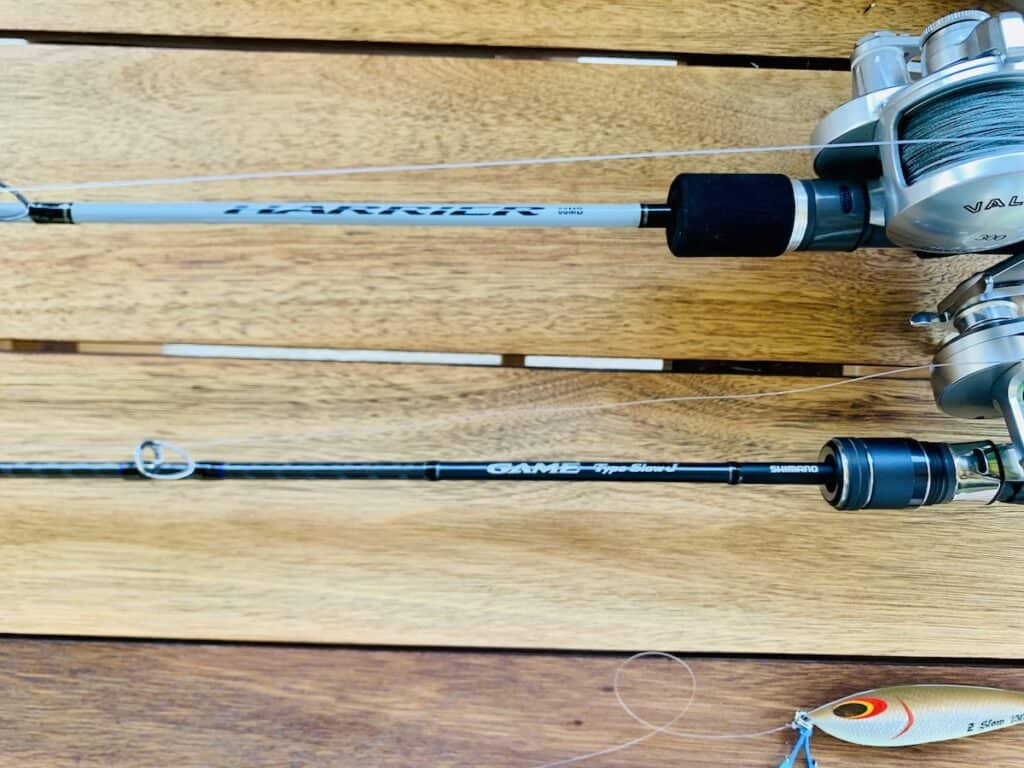
The rod’s weight can be reduced by choosing high strength, low weight components. Several aspects of the rod design can impact the weight. The rod construction greatly affects the weight. A lot of times you’ll see slow pitch jigging rods built with methods that increase the density of carbon fibers while simultaneously decreasing the amount of heavy resin used.
The rod guides also impact the weight. Rod guide frames can get extremely lightweight if made of titanium. Rod guide inserts can be made of several materials such as ceramic or silicon carbide. The higher end the rod, the lighter the rod guides generally are.
There are some additional features to look for in a slow jigging rod. To learn more, read my article Slow Jigging Rods.
Slow Pitch Reels Have Fast Retrieve
Slow jigging reels are compact and narrow conventional reels with high line capacity. The conventional reel is best because it gives the angler more control over the freespool speed. It also makes a more comfortable setup to hold in one hand all day.
The handle is also a key feature of slow jigging reels. On these reels you’ll see long handle arms and a large banana handle. This gives the angler the cranking power against big fish.
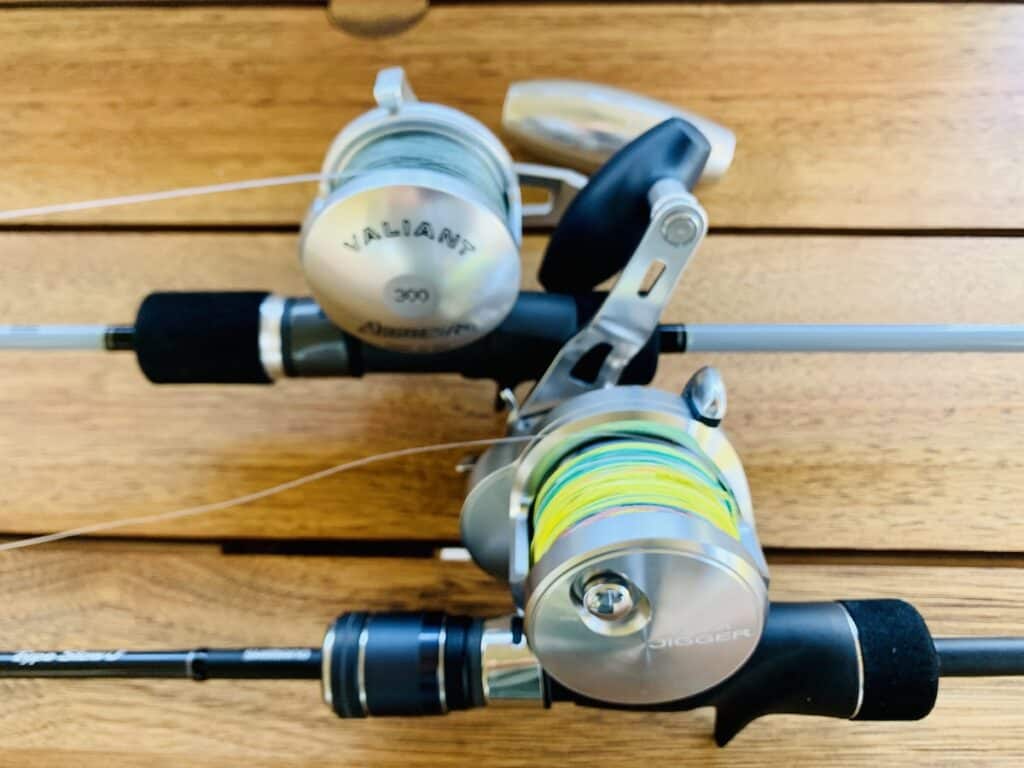
A fast retrieve rate will give anglers the best chance at landing the fish. Fishermen will fight the fish by cranking the reel. To learn how to choose the best reel for you, read my article Slow Jigging Reels.
Braid Main Line is Best for Slow Pitch Jigging
A key feature of the setup for slow pitch jigging is light weight. The reel is small and narrow, but you’ll still need hundreds of yards of line to reach bottom. The best line to maximize capacity of your reel is braid. Braid has a thin diameter and slow pitch jigging reels are meant to work with braid.
The thin diameter of braid also cuts through water easier. This is helpful because of the depths these slow pitch jigs need to reach. In fact, the thin diameter is so important that a light line, usually 30 lb test, is used when slow pitch jigging. In very deep waters, anglers will go even lighter strength to help slice through the water.
Braided main line also has the advantage of high sensitivity. There is virtually no stretch, so this means the angler can feel when the jig hits the bottom or when it gets struck by a fish. It is key for the angler to maintain a sense of where the bottom is, and braid helps achieve that.
My article Is Braid or Mono Best for Jigging? What Pound Test? discusses the pros and cons of using braid and mono as a main line for jigging.
Mono or Fluoro Leader Line
A leader is necessary when slow pitch jigging because the main line braid does not have good abrasion resistance. Slow pitch jigging is frequently done around structure and it’s common to make contact with the structure underwater. If the braid contacts the structure, it could tear and weaken the breaking strength of the line. Broken braid most definitely needs a lost fish and a lost jig.
Generally 15-30 ft of length is good for a jigging leader. Monofilament or fluorocarbon is used. Monofilament is cheap and highly abrasion resistant, and fluorocarbon is best used in very clear water for its invisibility. Usually the braided main line and mono leader are joined using an FG knot.
To learn how to choose the right pound test for your jigging leader, read my article Jigging Leaders: Why You Need One and How to Choose It.
Slow Pitch Jigs
Slow pitch jigs are heavy, unique lures with flashy color patterns. Some come prerigged with hooks, and some do not. These jigs use grams as a unit of measure and generally 100 grams per 100 feet of water is the approximate right size. Slightly larger jigs are used when the current is strong.
When currents are slow and light, a wider jig works well. When currents are strong, you’ll need a jig that gets down through the water faster, and that will be a slender jig. These jigs also tend to be rigged differently, although a lot of different rigging styles will work.
For short and wide jigs, I recommend using twin assist hooks. I would rig a pair on the top eyelet and a pair on the bottom eyelet with a split ring. You’ll also want a solid ring or ball bearing swivel between the top eyelet’s split ring and the leader line. The solid ring or swivel will give the lure more movability and prevent the abrasion on the leader line. The twin assist hooks also tend to be lighter gauge because multiple hooks will penetrate the fish and heavy gauge is unnecessary.
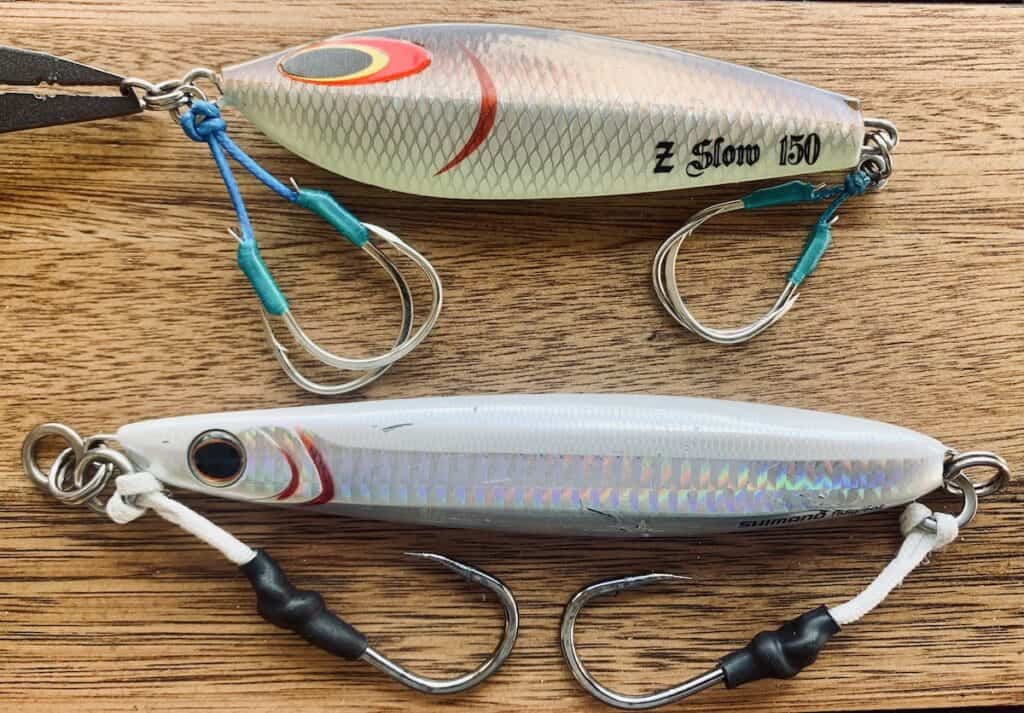
For long and slender jigs, I recommend using two single hooks. I would rig one on the top eyelet and one on the bottom eyelet with split rings. Again, you’ll add a solid ring or ball bearing swivel to the top eyelet’s split ring. These hooks tend to be heavier gauge to prevent the hooks from bending. The image above shows an example of both types of jigs and rigging methods.
You can attach these jigs to your leader using a snap or a Palomar knot. To learn more detail about slow pitch jigs and even more rigging techniques, read my article Slow Pitch Jigs.
Assist Hooks
The hooks used for slow pitch jigging are called assist hooks. You can rig a slow jig with anywhere between 1 and 4 hooks, so long as it aligns with recreational fishing laws in your area.
Twin assist hooks are usually lighter wire with lighter cord. They are rigged on one solid ring together. These hooks also face opposite directions. Although hooks like the Owner Dual Dancing Stinger twin assist hooks look so light that they’d bend in a heartbeat, they are strong and using a pair helps prevent hook bending.
Twin assist hooks are often attached to a split ring which is attached to the top or bottom eyelet of the jig. Either location, or twin hooks at both locations will work. With these hooks, you’ll often see one hook in the mouth and one in the gillplate, or other part of the face of the fish.
Single heavy wire hooks with heavy cord are also used. They can be attached to the top or bottom eyelet by attaching the cord to a solid ring, the solid ring to a split ring, and the split ring to the eyelet.
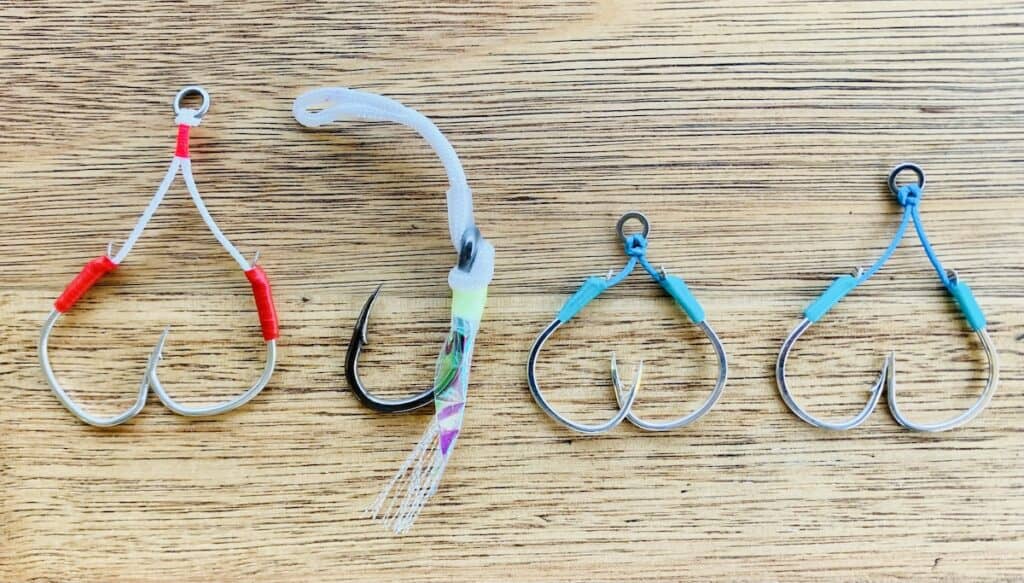
I hope this article helps you understand all there is to know about slow pitch jigging. Tight lines, y’all!

